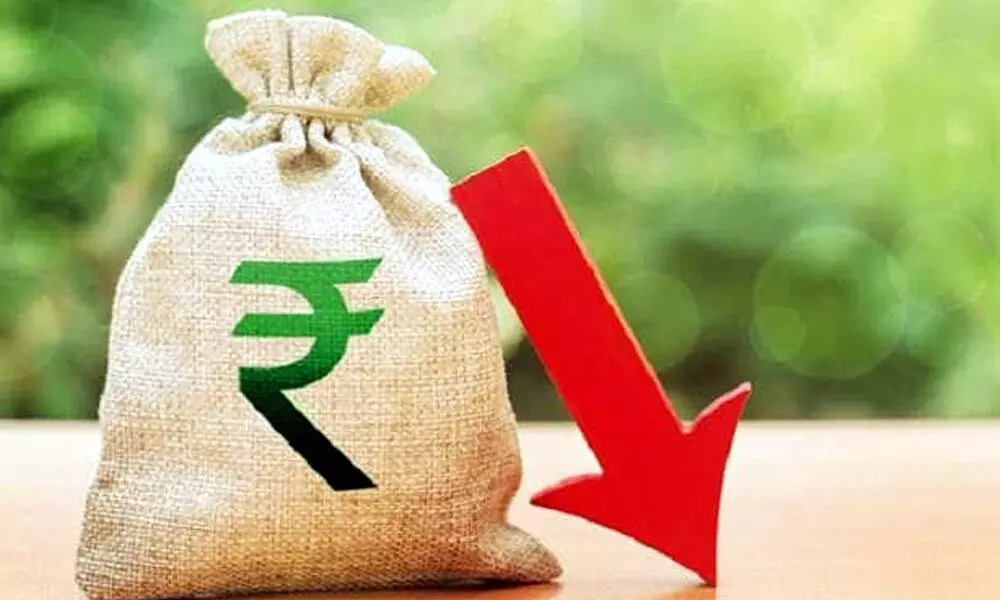6.5% fiscal deficit forecast in FY23, Centre's gross borrowing at Rs.12 lakh cr
The budget must focus on creating an enabling condition by giving higher weightage to short term stabilization policy ratherthan long term policy
image for illustrative purpose

Mumbai: Fiscal deficit in FY23 may be at 6-6.5 per cent, whereas gross borrowing by Centre likely to be at Rs12 lakh crore, says a report. After the economic jolt in FY21 due to Covid-19 outbreak, India'seconomy is slowly recovering. Thus, the main objective of the budget should be to create an environment by creating an enabling conditionby giving higher weightage to short term stabilization policy rather than long-term policy. The budget should also allow for very gradualfiscal consolidation. For FY23, the fiscal consolidation should remain limited to 30-40 bps from the current fiscal. Assuming that the Government keeps the expenditure growth at 8 per cent over FY22estimates at Rs 38 lakh crore in FY23 and receipts (minus borrowingand other liabilities) would grow by 10.8 per cent, it would lead tofiscal deficit of around Rs 16.5 lakh crore or 6.3 per cent of GDP in FY23.
If disinvestment of LIC passes through in FY22, Government might beending fiscal with a large cash balance of Rs3 lakh crore. This cancome handy in supporting a large part of government fiscal deficitwithout taking recourse to market borrowings. We caution that any new taxes like wealth tax or others at this point could do more harm than benefit.
Against this background, we thus believe net market borrowing of the Centre will be around Rs 8.2 lakh crore and with re-payments of Rs 3.8lakh crore, gross borrowing are expected at Rs 12 lakh crore (73 percent of the FD). Interestingly, in FY22, RBI has done OMOs of aroundRs 2.6 lakh crore that did support a large Government borrowingprogramme without disruptions. In FY23, sans the support of such OMOs,but with Rs 1.5 lakh crore expected through inclusion in bond indexand credit off take also picking up recently, there will still benorthward pressure on bond yields. Unless EM bond index announcementhappens in budget with first inflows starting in H2FY23, bond yieldsare in for major realignments in FY23.
The overall gross borrowings by Centre and States is likely to bearound Rs 21 lakh crore (Rs 19.7 lakh crore in FY22) and netborrowings around Rs 14.8 lakh crore (Rs 15 lakh crore in FY22).However, the movement in bond yields may also have a sobering impactgiven the proposed tweaks by RBI regarding bank's investmentportfolio, says an internal economic research report of SBI.
Regarding sector-specific suggestions, 6.33 crore MSME units in Indiacontribute 29 per cents to India's GDP, employing over 11 croreworkers. Credible source to verify cashflow and seamless access forBanks to GST 4 / ITR on real-time basis should be allowed for lendingto SMEs. Separately, availability of real time information on a singlewindow by Government through a regulatory architecture from varioussources viz. Income Tax, Ministry of Corporate Affairs (Registrar ofcompanies), Customs, Land Records, SEBI, Credit Information Companies,Banks and Courts (for legal cases if any) for a company/ borrower,will significantly enable informed credit decision in future for allborrowers.
The pandemic has created a renewed interest in the MSME space with abehavioural shift in bank lending to such units sur-passing allexpectations on the back of ECLG scheme launched by the Government.The ECLG scheme must be extended with necessary policy tweaks tillFY23. This will also enable completion of the entire targeted Rs 4.5lakh crore of credit flow under this scheme. Additionally, given thelittle success of federal guarantee scheme of CGTMSE in anchoring SMEsin its two decades odd existence, budget should explore reorientingthe institution along the lines of US-SBA as a facilitator to-wardsstarting and expanding business by SMEs. Such an agency should besingularly entrusted with a complete end-to-end digital platform witha primary focus on cash flow-based lending by financialintermediaries.
As on 31st March 2021, the data suggest that KCC loans for ASCBsaggregated to about Rs 7.53 lakh crore through 7.3 crore active KCCcard users, which constitute about 55 per cent of the totalagricultural loans outstanding by all the banks. It is intriguing thataccess to KCC loans is renewed every year only after the farmer haspaid both the principal and interest amount in totality.
"We propose that renewal of KCC loans of small and marginal farmersand for loans of other categories of farmers for amounts up to Rs 3lakhs, the payment of interest should be an enough condition forrenewal. Additionally, the interest subvention benefit which atpresent accrues only for crop cultivation and working capital loansfor allied agricultural activities can be extended to cover term loansfor investment credit purposes availed by small and marginal farmerswithout increasing the overall loan limit," says Soumya Kanti Ghosh,SBI group's chief economic advisor. This will spur investment credit for minor purposes on the fieldincluding drip irrigation, scientific mulching, land development forrainwater harvesting, water pumps, water shed management etc at theindividual farm lev-el. The above measure has the potential to alsoreduce credit cost for banks considerably on KCCs as NPAs can beprevented more easily and if the above suggestion is agreed upon byRBI, interest rate on KCC loans can be further reduced.

